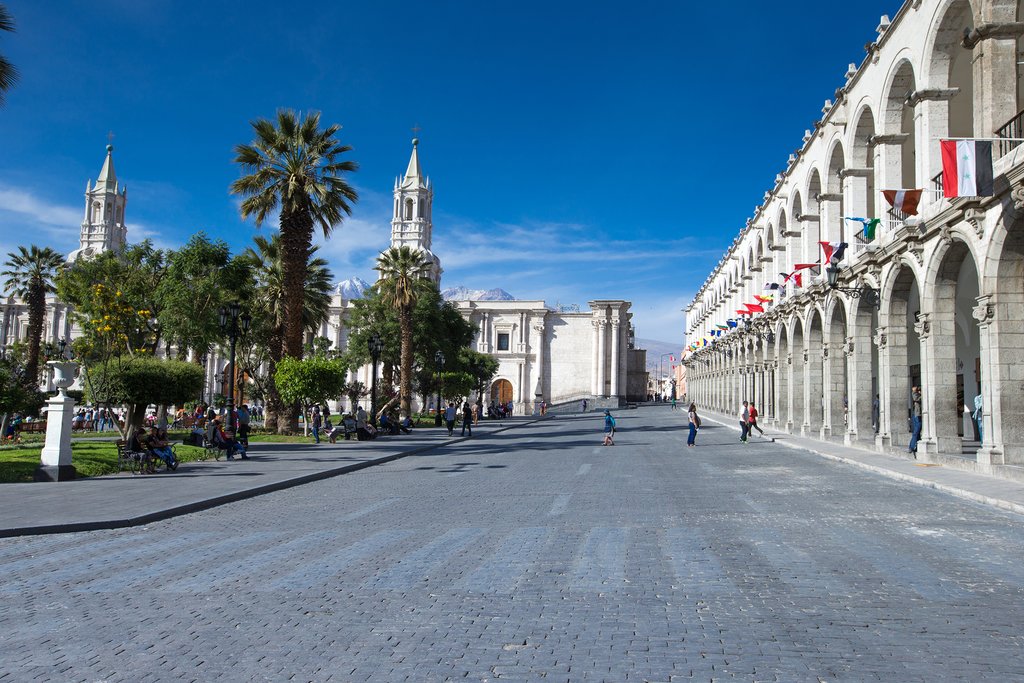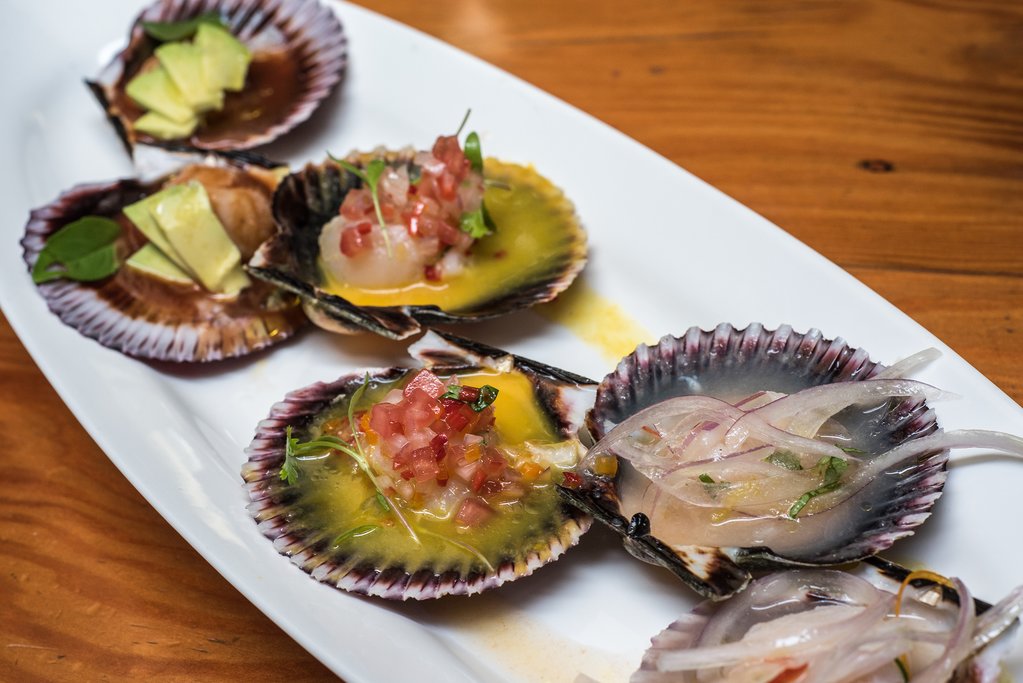Which Peru is Right for You?
Many travelers heading to Peru beeline to Machu Picchu, but the land of the Incas offers more than the famous citadel in the clouds. Mountains, beaches, rainforests, deserts, colonial cities—and the types of trips you can plan are just as varied as the landscape. Northern Peru holds opportunity for adventure, the Pacific Coast can host the dreamiest of honeymoons, and metropolitan Lima is the starting point for world-class culinary tours.
Decide where to base your Peruvian journey with our inspiring ideas below—and for additional insight, read more about the Best Places to Visit in Peru.
Arequipa for Adventure

In southern Peru, surrounded by volcanoes and filled with baroque buildings, lies the colonial city of Arequipa. This is the gateway to some of the country’s best adventure sports.
Thrill-seekers flock to the nearby Colca River to try their hand at rafting its white-water rapids. Hikers journey to the volcanos El Misti and Chachani to set foot on sleeping giants, or they head to the Andean highlands for high-altitude treks that challenge even the fittest mountaineers, all using Arequipa as a base. Try the Cotahuasi Canyon trek that starts north of Arequipa, taking you through villages, past waterfalls, and over the Cotahuasi River via suspension bridge.
The most popular day trip from Arequipa, however, is to Colca Canyon, which affords a singular sight: the endangered Andean Condor. These birds soar high above a deep and fertile chasm on wingspans of up to 10 feet. The Colca Canyon is 60 miles long, over 11,000 feet deep at its lowest point, and is lined with Pre-Columbian terraces. It's the second deepest canyon in the world. Interested? Here's a 4-day Colca Canyon trek to check out, or make it part of a longer 2-week itinerary.
Paracas for a Romantic Interlude

Paracas may not be a typical destination for a honeymoon or a romantic vacation, but then, there's nothing typical about Peru. Amorous couples can and should add this beach town to their wishlist. Start by booking a resort hotel—the Hotel Libertador Paracas and La Hacienda Bahia Paracas both have private beaches—before taking a sunset walk to the local waterfront restaurants, all featuring views over the fishing boats.
For day trips, there’s nearby Pisco, home to the namesake grape brandy that has achieved global popularity. There’s also the Islas Ballestas, arguably the number one reason visitors come to Paracas. You can book a boat tour to these uninhabited islands to see penguins, sea lions, and dolphins frolicking in the waters and pass one of Peru’s most famous sites: a huge petroglyph etched into a hillside in the shape of a candelabra.
Consider making Paracas the beginning of a week-long adventure in Southern Peru, continuing from the reserve to Colca Canyon and beyond. And for more great honeymoon ideas, check out this roundup of Peru's best locales for lovers.
Chat with a local specialist who can help organize your trip.
Cusco for Culture

Many visitors see Cusco as merely a jumping-off point for the rest of the Sacred Valley, but this colonial Andean city has plenty of cultural offerings in its own right.
Explorers can get lost in the many narrow alleyways, winding staircases, and hidden terraces. Around every corner is a shop selling colorful crafts, a restaurant serving up traditional llama and cuy (guinea pig), or a street stall proffering succulent beef-heart slices on skewers. All this culminates in the huge Mercado Central de San Pedro (central market), where textiles, household products, fresh produce, and prepared meals are sold under one roof.
Within steps of the nearby Plaza de Armas, itself home to a dominating 16th-century cathedral full of colonial paintings, you'll find museums of Incan history (Museo Inka), Pre-Columbian art (Museo de Arte Precolombiano), and even chocolate (ChocoMuseo). Meanwhile, at the Centro Qosco de Arte Nativo, you can catch traditional folk dances by costumed performers. You may have come to see Machu Picchu, but after a few days in Cusco, you won’t want to leave.
If you have 24 hours to spend here, our Perfect Day in Cusco guide has you covered from morning strolls to evening cocktails. For even more ideas, check out the Best Things to Do in Cusco.
Lima for a Culinary Journey

Great cities like New York, London, and Hong Kong benefit from a confluence of cultures, and Lima is no different. The city has attracted immigrants from all over the world for centuries, and this manifests in an unprecedented culinary richness. Several restaurants grace “best of” lists. These include Astrid y Gastón, run by hometown hero chef Gastón Acurio; Maido, with its elegant take on Nikkei (combination Peruvian-Japanese cuisine); and Centrale, headed up by Chef’s Table star Virgilio Martínez Véliz.
The beauty of Lima is that you don’t have to shell out a lot of money to eat well. Head to the beaches for the freshest ceviche, Barrio Chino for a Peruvian take on Chinese food, or trendy Miraflores for everything from old taverns to sleek clubs and quaint bistros. For just pennies, you can hit up the food carts outside the Lima Art Museum for corn on the cob, quail’s eggs, and fried potatoes and veggies.
This 10-day flavor and luxury tour is pure inspiration: spend three days on a Lima culinary tour through markets, fine restaurants, and cooking classes before moving on to Cusco and the Sacred Valley, staying in posh hotels along the way. Or opt for a 2-week journey that combines gastronomic experiences throughout the country with classic Peru sights and experiences.
And if the cuisine of Peru does get your taste buds going, check out this guide to the best food throughout the country.
Iquitos for Wildlife

The Amazon River typically conjures images of Brazil, yet this 4,000-mile waterway actually begins in the Peruvian Andes, close to the remote yet raucous jungle city of Iquitos. Only accessible by air or riverboat, glitzy hotels and early-20th-century mansions stand alongside mud huts and houseboats.
It's here that you can check several unforgettable wildlife encounters off your list: swimming with pink river dolphins, fishing for piranha, hunting for caimans at night, feeding gentle manatees, and viewing sloths at nearby reserves. Then, grab a multi-course meal just steps from where the fishermen unload the day's catch. For an even more indelible experience, book a multi-day boat tour of the Amazon—and be on the lookout for vibrant birds as you stop off at traditional villages along the way. The plum-throated cotinga, with its electric blue plumage, is unmistakable.
Take a look at this epic itinerary from Lima to Iquitos that includes a multi-day boat trip down the Amazon River. For more ideas for visiting the region, check out our Peruvian Amazon Highlights and the Greatest River Trips in the Peruvian Amazon.
Sacred Valley for Cycling

Northwest of Cusco, the Urubamba River runs through the "Sacred Valley." This was once the heart of the Inca empire, and in this region you'll find the ruins of Machu Picchu, Písac, Saqsaywaman, and others. Most easily accessible by car, you can also hike between the ruins via a network of high-altitude Incan trails.
Another fun way to see the area is traversing by mountain bike. Visitors who want in on this two-wheeled action can rent a bike and zip among the citadel ruins, hilltop terraces, and ancient villages dotting the Sacred Valley. Those who want extended journeys can take a tour lasting several days, with guides and equipment included.
Keep in mind that altitudes and climates can change rapidly from the Urubamba River lowlands to the cloud-covered highlands of Machu Picchu. Steep uphills followed by exhilarating downhills are to be expected, so plan and dress accordingly.
Travelers interesting in cycling should consider this week-long mountain bike tour of the Sacred Valley. Of course, there's always the possibility to add even more adreneline—the options for outdoor adventures in the Sacred Valley are many. For more area highlights, see this article.
Ica for Wine Tasting

While it might surprise some, wine has been produced in Peru since the 16th century. It was the Spanish colonists who brought grapes over from the Old World and set up vineyards on the grounds of Jesuit missions. Grown in a climate similar to Chile's (a country world-renowned for its viniculture), Peru’s varietals have been earmarked as the next big thing for years now.
The small city of Ica, just a short drive inland from Pisco and Paracas, is the best jumping off point for a tour of the vineyards, many of which make wine from the same grapes used to make pisco liquor. Book a stay at a wine resort, where gourmet meals are accompanied by local wines, or rove from vineyard to vineyard on a tour, where you'll taste for hours. (Pro tip: Make a stop in nearby Huacachina as well, a surreal palm-filled village surrounded by towering sand dunes.)
Ica makes a great stop between Paracas and Arequita, as featured in this roundup of great 5-day Peru trip options. Not sure how long you should stay? Here's an article to help you decide.
Family Vacay at Lake Titicaca

Often, getting from one place to another in Peru is a hectic undertaking that can involve several forms of transportation. In contrast, the relative peace and tranquility of Lake Titicaca make it a great destination for small children who may not be able to brave a long journey with many stops. What’s more, children will thrill at the chance to see Lake Titicaca’s floating “reed islands,” each inhabited by several local families.
A boat ride to the islands will allow children to interact with kids whose lives are markedly different from their own. They’ll love seeing the inhabitants’ colorful clothes, learning how their homes are built, and taking a ride on a barca (boat), also made of reeds. Check out this 10-day Southern Peru itinerary that includes a Lake Titicaca homestay, or add some time at the lake to this great 12-day tour of Peru created specifically for families.
Ready to begin? Here are some tips for planning a family trip to Peru.
